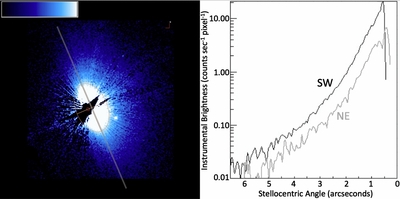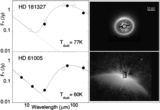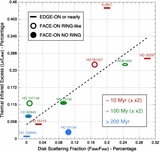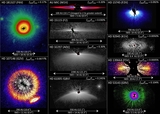Image Details

Caption: Figure 14.
Left: geometrical/isophote elliptical fit to the HD 15745 CS disk, in comparison to the location of the star (red circle) offset along the disk minor axis is indicative of very strong directionally preferential scattering by the disk material. The ellipse fit is to the 0.8 counts s−1 pixel−1 SB isophote (1 counts s−1 pixel−1 = 0.177 mJy arcsec−2), which is at r = 34.0 pixels (1![]() 73) from the disk center along the major axis (with a minor-to-major axial ratio of 0.615). Right: radial SB profiles along the disk major axis are of common slope, but differ throughout in brightness, suggesting a higher dust density distribution on the SW side of the star.
73) from the disk center along the major axis (with a minor-to-major axial ratio of 0.615). Right: radial SB profiles along the disk major axis are of common slope, but differ throughout in brightness, suggesting a higher dust density distribution on the SW side of the star.
Copyright and Terms & Conditions
© 2014. The American Astronomical Society. All rights reserved.












